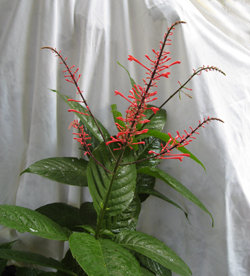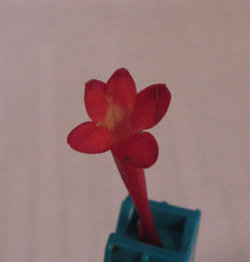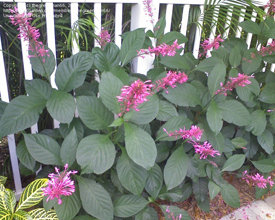





Firespike is blooming in gardens throughout Florida and much of the Deep South as fall approaches. Gardeners keep a close watch on it, not only because it is beautiful in and of itself, but also because it brings on a flurry of activity from the hummingbirds and butterflies that frequent the area.
Firespike is an evergreen shrub that forms clumps that increase at a very moderate rate from short root suckers. Stems are smooth and green, and as might be expected, they are woody toward the bottom of the stem and more succulent toward the stem tips that have more recently grown. Growth habit is upright on mostly unbranched stems, so the plant normally grows taller than it does wide, topping out at anywhere from 4 to 6 or more feet tall. Width depends on the circumference of the clump.
 Glossy, oblong leaves that are 4 to 8 inches long with entire, wavy margins and long pointed tips grow opposite each other up the stem. The plant with just its leaves is an attractive landscape specimen, but when it blooms, it moves into the realm of the spectacular. From late summer through winter, or until frost cuts it down, firespike produces abundant clusters (racemes) of brilliant red flowers at the outer tips of the stems. Clusters are 9 to 12 inches long, and each inch-long floret (individual flower) is tubular and rather club shaped as buds, but when the buds open the flower tip flares into a half-inch diameter arrangement of five petals that are more easily pictured than described.
Glossy, oblong leaves that are 4 to 8 inches long with entire, wavy margins and long pointed tips grow opposite each other up the stem. The plant with just its leaves is an attractive landscape specimen, but when it blooms, it moves into the realm of the spectacular. From late summer through winter, or until frost cuts it down, firespike produces abundant clusters (racemes) of brilliant red flowers at the outer tips of the stems. Clusters are 9 to 12 inches long, and each inch-long floret (individual flower) is tubular and rather club shaped as buds, but when the buds open the flower tip flares into a half-inch diameter arrangement of five petals that are more easily pictured than described. 
Cultural Preferences
Firespike appreciates fertile to moderately fertile, moist soil, and will grow in a wide range of light exposures. In full sun the plants grow smaller and a bit more compact than they do in partial shade. Partial shade seems to be its preference. With just a bit of protection from the full, burning rays of the sun, it grows taller and the leaves grow larger. In full shade, it is likely to stretch and become a bit long and lanky. However, it will bloom in all these exposures. In full sun, the leaves are apt to wilt when the sun is at its peak, but they rebound when the sun becomes less intense.
Firespike is evergreen in the tropics. Farther north (to Zone 8), the first frost turns the leaves to shriveled, limp, brown appendages and the succulent stems to ugly black sticks. This is the time to trim all the stems back to the ground and to cover the crown with pine needles or other loose, organic mulch. The following spring, it again sends up succulent green stems from the roots. Since it takes the plant all summer to grow to blooming size, it is a fall bloomer in Zone 8. North of Zone 8, firespike is best grown as an annual or in containers that can be moved to protected places during the winter.
Firespike is both heat and drought tolerant, but is not a good choice for areas where salt tolerance is a factor. Few pests are bothersome, but occasional mealy bug infestations have occurred. Butterflies and hummingbirds relish the nectar, and white-tailed deer find the leaves quite tasty. Normally, very little care is needed, and it is a low maintenance, easy-to-grow plant.
Propagation is easy from cuttings. Simply cut a stem and place it in damp soil. Stems will root if they fall over on the ground. This ease of propagation may be a blessing, or it may be a curse. While the plant is native to open, semi-forested areas in Central America, it has escaped cultivation and become naturalized in Cuba, Puerto Rico, Hispaniola, and peninsular Florida. Most escapees became established from abandoned gardens or from pieces of stem or root that were dumped in the woods. Seeds do not germinate easily, so most new plants are generated from stem or root pieces.
Odontonema callistachyum is a species that bears beautiful pink or purple flower spikes, depending on the cultivar. It is a less dependable plant in Zone 8 because it blooms later than O. strictum, which places its bloom squarely into winter. We in Zone 8 rarely get to see this beautiful plant in flower because frost cuts it down before the flowers appear.
The Scientific Name Dilemma
Determining the scientific name of firespike has been quite a challenge, and I must admit, it remains a conundrum. Some references say that the species name is Odontonema strictum, and that's what I called it for years. Others insist on O. cuspidatum, while others choose O. tubaeforme. To compound the problem, the GRIN (Germplasm Resources Information Network) website that I rely on so heavily for correct plant identification does not list Odontonema strictum as anything but a synonym of O. cuspidatum, so I suspect that it has undergone a name change by our venerable taxonomists.
The GRIN website lists four species, including O. callistachyum, O. cuspidatum, O. nitidum, and O. tubaeforme. Pictures found on the internet clearly distinguish O. callistachyum and O. nitidum as being different, but the same plant is pictured in most places for O. cuspidatum and O. tubaeforme (spelled tubiforme by some reputable references). If I must choose one of these, I lean towards O. cuspidatum because it is listed by more references than O. tubaeforme. I think that for the time being I'll just call it firespike. Maybe some of Dave's Garden readers can help with the scientific name dilemma. Whatever its scientific name, firespike is a beautiful addition to gardens in Zones 8-11.
At a Glance
Common names: firespike, cardinal guard, scarlet flame
Family: Acanthaceae (acanthus Family)
Hardiness: USDA Zones 8 - 11
Origin: Mexico and Panama
Salt tolerance: none
Thanks to thegreenman66 for his beautiful image of O. callistachyum.Copyright © www.100flowers.win Botanic Garden All Rights Reserved